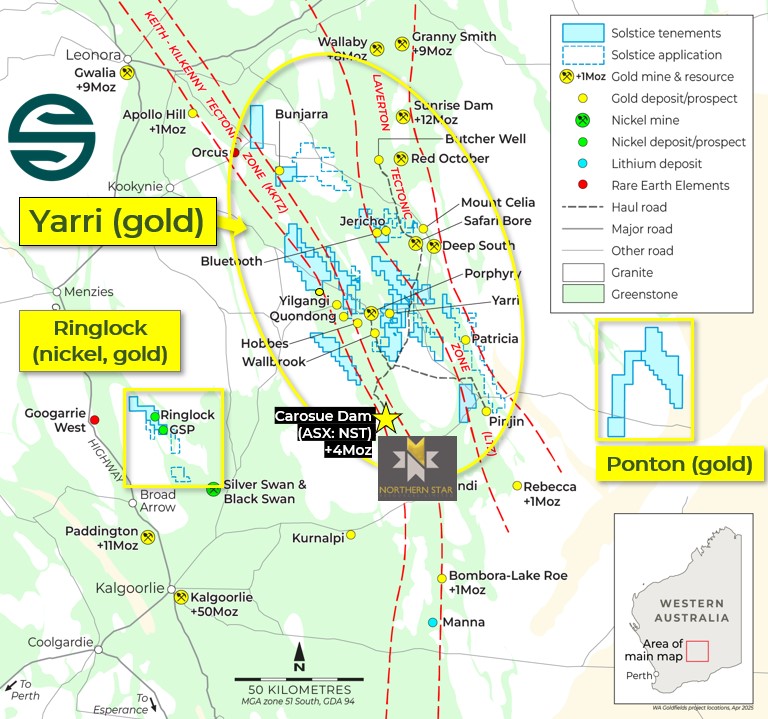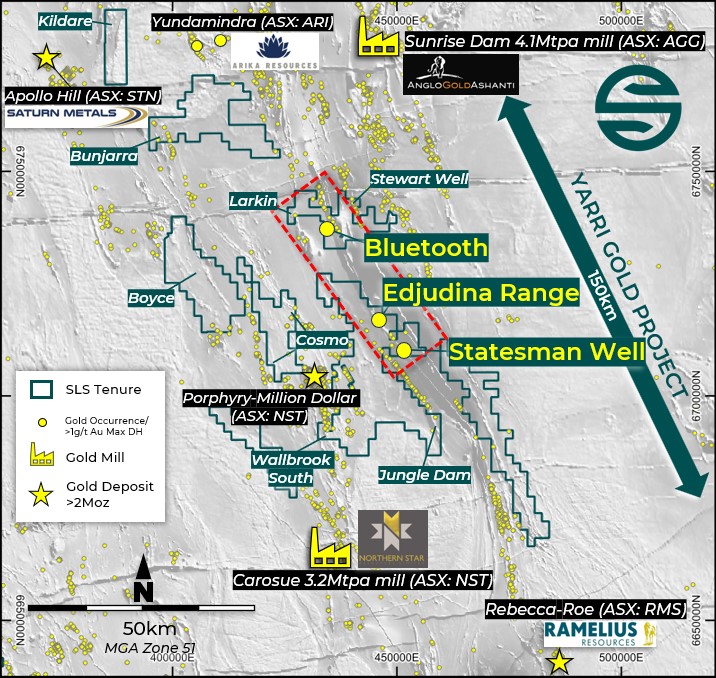Yarri Project
(Gold)
Solstice is focusing its exploration activity across its gold targets within the Yarri Project extending over more than 120km strike of prime gold exploration terrain straddling the Keith-Kilkenny Tectonic Zone (KKTZ) and the Laverton Tectonic Zone (LTZ), both craton-scale structural features known to control gold mineralisation in the Eastern Goldfields. The strategy is to test new ‘stand-alone scale’ gold targets in gold endowed greenstone belts – particularly where shallow (<40m) transported soil cover has prevented effective historical exploration. Solstice is in an excellent cash position to search for new commercial gold systems in the Yarri area, utilising a comprehensive regional database and a belt-scale regional tenement footprint. The landholding is continually reviewed as targets evolve, with the Company making strategic Licence acquisitions where it sees under-explored gold potential, and divestments as opportunities present.


Bluetooth Prospect
Bluetooth is located within 9km of haul road infrastructure, approximately 35km north of the Porphyry mining centre, and 40km southwest of AngloGold Ashanti’s Sunrise Dam gold deposit. The Prospect is one of Solstice’s advanced gold exploration targets, with gold prospectivity demonstrated by strong rock-chip and soil sampling gold geochemistry and promising intercepts in widely spaced shallow historical Rotary Air Blast (RAB), aircore and RC drilling.
Solstice’s first-stage RC drilling completed in December 2024 comprised 19 shallow RC holes for 1,830m in a first-pass pattern covering 900m of strike. The program returned strong gold intercepts, including a standout intercept of 29m @ 1.58g/t Au in BTHRC016 plus 12m @ 2.86g/t Au in BTHRC013 and 12m @ 1.57g/t Au in BTHRC014.
Phase II drilling completed in May 2025 (14 RC holes for 1,050m) was designed to build on the strong intercepts from the initial phase, and in widely spaced historical drillholes. Significant results include 20m @ 1.98g/t Au in BTHRC026, 23m @ 1.38g/t Au in BTHRC032 and 1m @ 1.89g/t Au in BTHRC027.
These results prompted a Phase III round of drilling of
approximately 16 RC holes for 1,500m that commenced in mid July 2025 and aim to
further scope the commercial potential of this emerging gold system by extending
outcropping/near-surface gold lodes as well as testing key down-plunge
positions.
Gold mineralisation reports to gently east-dipping chert, ironstone and quartz veining in the oxidised profile, and confirms and upgrades historical intercepts recorded in shallow drilling at the Prospect, including 12m @ 1.31g/t Au to end of hole (EOH), 15m @ 0.95g/t Au, 8m @ 1.66g/t Au and 2m @ 5.07g/t Au to EOH.
Edjudina Range
The Edjudina Range Gold Prospect is a completely new mineralised surface identified late 2024 via reconnaissance aircore drilling of magnetic trends below shallow transported cover. A first traverse returned widespread gold anomalism including an intercept of 2m @ 3.17g/t Au EOH in EDRAC027. Subsequent step-out and infill drilling confirmed significant gold mineralisation to over 1km strike.
A two-hole initial RC drill test (EDRRC001-EDRRC002 for 220m) on the discovery traverse returned 20m @ 1.02g/t Au from 36m down-hole in EDRRC001. A 20-hole aircore drilling program for 1,520m designed to further delineate and extend bedrock gold mineralisation was completed in June 2025 and a follow-up RC program to include 50m step-out tests and a scissor drillhole was completed in July 2025 (assays pending).
While drilling at Edjudina Range remains at wide traverse spacing, the prospect has already shown it can deliver commercial-grade gold intercepts. The geological setting is considered stratigraphically equivalent to Statesman Well and lies on the same trend as Bluetooth, located 23km to the NW, and sits close to an active haul road and within 20km of Northern Star’s Porphyry Mining Centre.
Statesman Well Prospect
This Prospect is marked by a 1km trend of small gold workings in quartz veined banded iron formation and lies within 20km of Northern Star’s Porphyry Mining Centre, and close to existing haul road infrastructure. Historical shallow RC drilling in several locations along the trend outline a zone of continuous gold anomalism (>0.20g/t Au) of significant width, that hosts multiple commercial grade gold intercepts including 22m @ 1.14g/t Au in SW19, 10m @ 2.04g/t Au in SW27 and 24m @ 0.81g/t Au in SW10.
Solstice completed a first phase of RC drilling at the Prospect in Q2 2025, with a 22-hole shallow program that confirmed the potential of the ~1km long mineralised surface. Assay results defined zones of mineralisation for further drilling, including in the vicinity of a shallow high-grade near-surface intercept of 8m @ 7.94g/t Au from 12m in STWRC003 (including 1m @ 39.75g/t Au from 13m and 1m @ 16.10g/t Au from 19m). Other significant results included 12m @ 1.44g/t Au from 88m in STWRC002, 4m @ 2.54g/t Au from 52m in STWRC027, and 12m @ 0.76g/t Au from 16m in STWRC022.
Drilling also identified wider zones of strong anomalism in the host horizon, including 24m @ 0.27g/t Au from 44m in STWRC001, 20m @ 0.35g/t Au from 48m in STWRC006, and 16m @ 0.35g/t Au from 28m in STWRC0073. These thickened zones may point to grade potential nearby.
Statesman Well lies within 20km of Northern Star’s Porphyry Mining Centre (Figure 2) and adjacent to existing haul road infrastructure.
Bunjarra Licence
Bunjarra lies in a compelling geological setting approximately 70km northwest of Northern Star’s (ASX: NST) Porphyry mining centre, 20km southeast of Saturn Metals’ (ASX: STN) Apollo Hill gold deposit and along strike from a significant competitor gold drill-out to the south.
The Licence is covered by a blanket of shallow transported alluvial material that has limited the effectiveness of previous exploration. Aircore drilling has continued to build a picture of widespread gold anomalism in the weathering profile at this Prospect. Several anomalous trends have emerged, each extending over at least a kilometre and combined, highlight the potential to discover valuable mineralised structures in the underlying fresh-rock profile.
Significant composite results include 5m @ 1.58g/t Au in BJWAC074, 5m @ 1.33g/t Au in BJWAC083, 10m @ 0.43g/t Au in BJWAC104, 10m @ 0.14g/t Au EOH in BJWAC099, and 20m @ 0.17g/t Au in BJWAC115. Solstice’s aircore drilling programs at Bunjarra have progressed the Project toward a first-ever RC drilling program.
Image Gallery